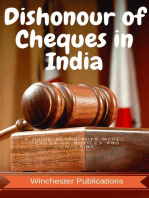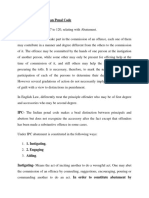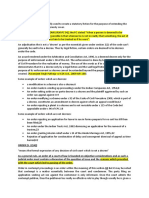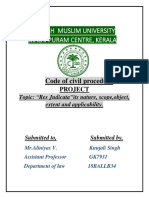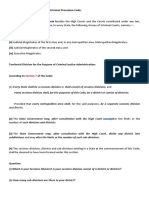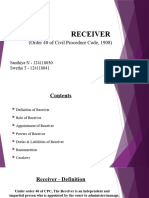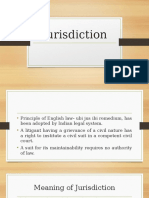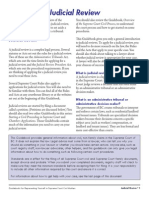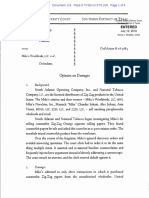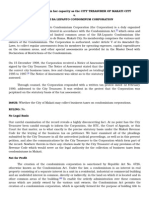0 ratings0% found this document useful (0 votes)
205 viewsLimitation
Limitation
Uploaded by
Pragya GuptaThe document discusses the laws of limitation in India. It provides three main reasons for limitation acts: 1) long dormant claims can cause more cruelty than justice, 2) defendants may lose evidence to dispute stale claims, and 3) plaintiffs should reasonably pursue claims in a timely manner. It also notes that limitation bars the remedy but not the underlying right, and discusses exceptions, tolling of time periods, and what constitutes "sufficient cause" to extend deadlines.
Copyright:
© All Rights Reserved
Available Formats
Download as PPTX, PDF, TXT or read online from Scribd
Limitation
Limitation
Uploaded by
Pragya Gupta0 ratings0% found this document useful (0 votes)
205 views37 pagesThe document discusses the laws of limitation in India. It provides three main reasons for limitation acts: 1) long dormant claims can cause more cruelty than justice, 2) defendants may lose evidence to dispute stale claims, and 3) plaintiffs should reasonably pursue claims in a timely manner. It also notes that limitation bars the remedy but not the underlying right, and discusses exceptions, tolling of time periods, and what constitutes "sufficient cause" to extend deadlines.
Original Description:
limitation
Original Title
limitation
Copyright
© © All Rights Reserved
Available Formats
PPTX, PDF, TXT or read online from Scribd
Share this document
Did you find this document useful?
Is this content inappropriate?
The document discusses the laws of limitation in India. It provides three main reasons for limitation acts: 1) long dormant claims can cause more cruelty than justice, 2) defendants may lose evidence to dispute stale claims, and 3) plaintiffs should reasonably pursue claims in a timely manner. It also notes that limitation bars the remedy but not the underlying right, and discusses exceptions, tolling of time periods, and what constitutes "sufficient cause" to extend deadlines.
Copyright:
© All Rights Reserved
Available Formats
Download as PPTX, PDF, TXT or read online from Scribd
Download as pptx, pdf, or txt
0 ratings0% found this document useful (0 votes)
205 views37 pagesLimitation
Limitation
Uploaded by
Pragya GuptaThe document discusses the laws of limitation in India. It provides three main reasons for limitation acts: 1) long dormant claims can cause more cruelty than justice, 2) defendants may lose evidence to dispute stale claims, and 3) plaintiffs should reasonably pursue claims in a timely manner. It also notes that limitation bars the remedy but not the underlying right, and discusses exceptions, tolling of time periods, and what constitutes "sufficient cause" to extend deadlines.
Copyright:
© All Rights Reserved
Available Formats
Download as PPTX, PDF, TXT or read online from Scribd
Download as pptx, pdf, or txt
You are on page 1of 37
Limitation
Some extra slides
object
• Basically the laws of limitation are founded on
the public policy. The object of the limitation
act is quiet long possession and extinguish
stale demands.-rajendra singh v/s santa singh
AIR 1973.
• The idea is that every legal remedy be alive for
a legislative fixed period of time.
• There are three different reasons supporting
the existence of statutes of limitation,namely
(halsbury’s laws of england)
• 1) that long dormant claims have often more
of cruelty than justice in them (it is unfair that
a defendant should have a claim hanging over
him for an indifinite period)
• 2) that a defendant might have lost the
evidence to dispute the stale claims
• 3) that persons with good cause of action
should pursue them with reasonable
deligence (it relates to the conduct of plaintiff,
a person who does not promptly act to
enforce his rights should lose them).
• An unlimited and perpetual threat of litigation
creates insecurity and uncertainity,some kind
of limitation is essential for public order and
peace.A constant dread of judicial process and
a feeling of insecurity retard the growth and
prosperity of a nation.Thus, the statutes of
limitation are known as “statutes of repose’’
or ‘’statutes of peace’’.
Limitation bars remedy but not the
right
• The rule of limitation is a rule of procedure, a
branch of the adjective law. It does not either
create or extinguish rights,except in the case
of acquisition of title to immovable property
by prescription under section 27 of limitation
act. A law of limitation affects the remedy
merely,it does not touch the right of a person
to the debt,damage,goods,person ,propertt
etc.
• The rules of limitation are not meant to
destroy the rights of the parties-babua ram
v/s state of up- they are meant to see that
plaintiff does not take a dilatory tactics but
seeks remedy within the period stipulated by
the legislature.The right continues to exist
even though the remedy is barred by
limitation.
• It is only the remedy ‘by way of a suit’ that is
barred but the right itself continues to
exist,and if there is some remedy or lawful
means by which the right can be enforced,the
limitation act cannot come in the way.The
concept ‘time barred’ cannot be extended to
proceedings outside the courts.
• Section 3
• 4 to 24 is an exception
• Section 3 is pre emptory and the duty of the
court is to take note of the act and give effect
to it,even though limitation is not reffered to
in the pleading
• Burdern of proof-normally, defendant must
plead the bar of limitation. Thus the initial
burdern of proving that the plaint or appeal is
within time vests upon the plaintiff or
appellant.However,later, the burden may shift
to the defendant (eg where the suit as framed
by the plaintiff is within time under a
particular article but the defendamt puts up
the bar of limitation
• Limitation being a matter of statute, section 3
leaves no room for equitable considerations.
• Section 3 operates for or against a private
indiviual as also government.
• Duty of court- richard jaison v/s padmanbhan-
AIR 1957
• Section 4 –expirt of precribed period when court
is closed
• Section 4 deals with extension of time over that
period during which a person is delayed by the
court’s action and not by any act on his own.
Section 4 gives expression to the maxims
• 1) lex non cogit ad impossibilia-the law does not
compel a man to do that which he cannot
possibily perform
• 2) actus curiae neminem gravabit-an act of the
court shall not prejudice any party.
• The provisions of section 4 is a priveledge
given to the plaintiff or appellant. When the
period of limitation expires on a gazaated
holiday,and the plaint is presented on the day
the court re opens, it is not neceesary to state
the fact in the plaint
• A court is said to be closed even though the
judge holds on a gazatted holiday.
• Section 5
• Section 5 is an exception to the general rule contained
in section 3 ( bar of limitation) and would dilute the
rigour of section 3. Section 5 does not apply to suits
i.e. to the original cause of action. The reason is that
the period prescribed for the most of the suits extends
from three to 12 years. While the period prescribed for
appeals and applications mentioned in this section do
not exceed six months,some concession
has,therefore,been allowed in respect of these appeals
and applications
• It is the duty of the court to record the
reasons for extending the time uner section5.
• It may be noted by section 5 does not provide
that an application in writing must be filled
before relief under the said provision can be
granted. Delay can be condoned even when
no written application is filed.
Conditions for condonation of delay
• 1) the right to the respondent accrued to him
by lapse of time should not be disturbed light-
heartedly.
• 2) that if sufficient cause is proved by the
applicant he does not acquire automatically
the right to have the delay condoned but
section 5 vests in court with the discretion to
condone the delay.
Guidelines
m. balakrishnan v/s m.
krishnanmurthy
• 1) the party seeking relief has to satisfy the court that
he had sufficient cause for not preffering the
appeal,etc,within the prescribed time. If the party fails
to show sufficient cause,the cause shown for the later
period may not be relevant.
• 2) the explanation has to cover the entire period of
delay i.e. delay made after the last day of limitation to
day till the actual date of filling the application. The
event or circumstances accounting for the delay “must
arise” before the expiry of limitation period,no event
or circumstances arising after the expiry of limitation
can constitute sufficient cause,though it may further
delay the filing of appeal or application.
• 3) the proof of sufficient cause is a condition
precednt for the exercise of the discretionary
jurisdictiona vested in the court under section
5. the court have discretion to admit or refuse
to admit the proceeding,even if sufficient
cause is shown,as is made clear by the words
“may be admitted”used in the section.
• 4)the discretion conferred on the court is a
judicial and not arbitrary discretion.
• 5)court in the exercise of disretion under
section 5 is whether the appellant acted with
reasonable deligence in prosecuting the
appeal.The period for preffering an appeal
must not be extended simply because the
appellant’s case is hard and calls for
sympathy.The court has no power to extend
the period of limitation on equitable grounds.
• The court should adopt a pragmatic approach
• ‘Sufficient cause’- is adequately elastic to enable
the courts to apply the law in a meaningful
manner which sub serve the ends of justice
• 1) refusing to condone delay can result in
mertitorious matter being thrown out at the very
threshold and cause of justice being defeated.As
against this when delay is condoned the highest
that can happen is that a cause would be decided
on merits after hearing the parties
Every days delay to be asked not every hour
every second
Depending upon case
Sufficient cause
• The expression “sufficient cause” is not
defined in the Act but it has been held that it
must mean a cause which is beyond the
control of the party invoking
• Section 5-therefore, a cause for delay which a
party could have avoided by the exercise of
due care and caution cannot be a sufficient
cause
• The privy council in krishna v/s chattappan –
said that the considerations for determining
sufficient cause are-
• A) it must be a cause which is beyond the
control of the party
• B) the party must not be shown to be
negligent,inactive or lacking in bonafides
• The following are some of examples of what is
and what is not “sufficient cause”
• 1)illness- it may be a sufficient cause, but it must
be proved that the man was utterly disabled to
attend to any duty.Illness of pleader,and the
client’s ignorance of it,might be a sufficient
cause.Illness in the family and subsequent delay
in making arrangements for the appeal or
applications is not sufficient cause (except under
exceptional circumstances).Delay due to accident
was accepted as sufficient cause.
• Imprisonment-imprisonment may be considered as a
sufficient cause in certain circumstances,and the time
spent in jail may be deducted,but ordinarily it is not so.
• Illiteracy,poverty,miniority,widowhood and purda-all
these are not sufficient cause under section 5.
Hardship is no ground for condonation. The poverty of
appelant in consequence of which he was not able to
pay court fee in time is not a sufficient cause for
admitting an appeal out out of time.
• Little liberal with purda woman
• Mistake of counsel-mitake of fact
• But not mistake of law.
• Wrong proceeding taken in good faith
• Proceedings in wrong court through bonafide
mistake
• Defective vakalatnama
• Inability to get stamps
• Negligence of servant/counsel’s clerk/agent
• Mistake of court
Section 6-generally limitation begins to run from
the date of accrual of the cause of the action.
Section 6 is one of te exception to general
rule. In this and similar cases, the period of
limitation does not run from the date of
accrual of cause of action but runs from a
subsequent date i.e. the date on which the
disability cease. The object of the section is
not to place minors or lunatics under special
concessions
• The section merely means that no limitation
will apply to a case in which the person suing
was disqualified at the time when the cause of
action arose provided the suit is brought
within three years of the time when the
disqualification ceases
• Section 6 –legal disability to sue owing to
miniority,lunacy or idocy
• 1)section 6 does not provide for a fresh
starting point of limitation. The section does
not prevent running of limitation but only
extends the period of limitation. Further,
governed by sec6-7-8
• 2) they are incapable of forming a proper
jugdment as to bringing suits or otherwise
managing their own affairs.
• Section 6 only applies to suits,etc brought by and
not against persons under disability. A plaintiff
himself under no disability is not entitled to the
benefit of the section merely because the
defendant is under a disability.
• No disability other than those mentioned in the
act (miniority,lunacy,idiocy)save limitation-war
and rebellion for instance do not check limitation.
• Section 6 applies only when the disability is in
excistence at the time when the limitation
begins to run. If a disability supervenes
susequently, then benefit of this
sectioncannot be taken
Section 9
• Where once time has begun to run, no subsequent
disability or inability to institute a suit or make an
application stops it
• The rule as to the continous running of time is one of
the fundamental principles of the law of limitation.This
rule lays down that where once time has begun to
run,it runs continously and without any breaks or
interruptions until the entire prescribed period has run
out, and has no disability or inability to sue occuring
subsequently to the commencement will stop its
running
• 1)if at the date on which the cause of action arose the plaintiff was
under no disabbility or inability,the time will naturalyy begin to run
against him because there is no reason why the ordinary law should
not have full operation.
• The principle may seem a little harsh at times, as it may be
impossible to file a suit during the last few days of the period by
reason,for instance,of the plaintiff falling severly ill,or becoming
insane or being called away elsewhere on some pressing
business,or by reason of circumstances which may be beyond the
controll of plaintiff,such as a decleration of the war with the country
of ehich the plaintiff is a subject,or the sudden death of the
defendant and the non appointment (before the period is over) of a
legal representative who can be sued.
• But the plea of limitation being devised for
promoting deligence and discouraging laches
or indolence of any sort,requires that a person
should be diligent and file a suit in respect of
his right as quickly as possible,and not allow
matter to slide until a dangerously late hour
when the prescribed period is on the point of
running out.
• 2) section 9 applies to a person himself as well
as to his representatives in interest after his
death.
• 3) the section contemplates a case of
subsequent disability and not of initial
disability.
• 4)times run when cause of action acrues.
You might also like
- A Suit For PartitionDocument5 pagesA Suit For PartitionPragya Gupta83% (6)
- 1.a. Bus Articles of IncorporationDocument6 pages1.a. Bus Articles of IncorporationNyfer JhenNo ratings yet
- DMO 1999-10 Qualified PersonsDocument6 pagesDMO 1999-10 Qualified Personsmark6villegasNo ratings yet
- Dishonour of Cheques in India: A Guide along with Model Drafts of Notices and ComplaintFrom EverandDishonour of Cheques in India: A Guide along with Model Drafts of Notices and ComplaintRating: 4 out of 5 stars4/5 (1)
- Relevancy of FactsDocument70 pagesRelevancy of FactsPragya GuptaNo ratings yet
- Notice of Intent To Exercise Warehouse Lien by AuctionDocument2 pagesNotice of Intent To Exercise Warehouse Lien by AuctionAl MineNo ratings yet
- 9 Bulletin Publishing Corporation vs. Sanchez G.R. No. 74425 October 71986Document2 pages9 Bulletin Publishing Corporation vs. Sanchez G.R. No. 74425 October 71986lexx100% (1)
- Sufficient CauseDocument6 pagesSufficient CauseNarayan SubramanianNo ratings yet
- Appeals From Original DecreeDocument11 pagesAppeals From Original DecreeChinmoy Mishra100% (1)
- Bhanu Kumar Jain v. Archana Kumar Air 2005 SC 626Document28 pagesBhanu Kumar Jain v. Archana Kumar Air 2005 SC 626Anurag Chaurasia75% (4)
- Project On Appeals Under Code of Criminal Procedure, 1973: AcknowledgementDocument20 pagesProject On Appeals Under Code of Criminal Procedure, 1973: AcknowledgementkartikNo ratings yet
- Assignment: Topic: - Summon in Civil SuitDocument12 pagesAssignment: Topic: - Summon in Civil SuitMohammad Ziya AnsariNo ratings yet
- Jurisdiction of CPC & Baring of Suits Section 9Document5 pagesJurisdiction of CPC & Baring of Suits Section 9Elated TarantulaNo ratings yet
- Res SubDocument5 pagesRes SubPurva ThaviNo ratings yet
- Place of SuingDocument16 pagesPlace of SuingGargi DasNo ratings yet
- Section 6 - 10 of Limitation Act, 1963: DisabilityDocument6 pagesSection 6 - 10 of Limitation Act, 1963: DisabilityKratika JoshiNo ratings yet
- Abatement Under Indian Penal CodeDocument11 pagesAbatement Under Indian Penal CodeIMRAN ALAMNo ratings yet
- Accomplice Witness and Its Admissibility As EvidenceDocument7 pagesAccomplice Witness and Its Admissibility As Evidencesheikhshaim100% (1)
- LLB 5TH Sem CPC Unit 5Document8 pagesLLB 5TH Sem CPC Unit 5Duby ManNo ratings yet
- Legal Incidents of PlaintDocument31 pagesLegal Incidents of PlaintApoorvNo ratings yet
- Execution of DecreeDocument10 pagesExecution of DecreeRishika Gautam100% (1)
- Civil Procedure CodeDocument7 pagesCivil Procedure CodeKshitij AsthanaNo ratings yet
- Difference Between Review and ReferenceDocument2 pagesDifference Between Review and ReferenceSiddhant RadhuNo ratings yet
- Cr. P CDocument59 pagesCr. P CSonali SinghNo ratings yet
- DEEMED DECREEDecree, Order and JudgmentDocument4 pagesDEEMED DECREEDecree, Order and JudgmentVikram BijNo ratings yet
- Review PetitionDocument8 pagesReview PetitionJyotiNo ratings yet
- Tofan Singh JudgementDocument9 pagesTofan Singh Judgementakira menonNo ratings yet
- Provisions Regarding The Acquisition of Ownership by Possession Under The Law of LimitationDocument5 pagesProvisions Regarding The Acquisition of Ownership by Possession Under The Law of LimitationsrishtiNo ratings yet
- Res Judicata Under Civil Procedure Code, 1908Document15 pagesRes Judicata Under Civil Procedure Code, 1908MR VIDEOSNo ratings yet
- SLPDocument116 pagesSLPAnkit KumarNo ratings yet
- Code of Criminal Procedure Project ReportDocument28 pagesCode of Criminal Procedure Project ReportUdhayveer Thakur50% (2)
- Limitation Act 1963Document24 pagesLimitation Act 1963Dikshagoyal1230% (1)
- CRPC DifferencesShortNotesDocument6 pagesCRPC DifferencesShortNotesamitrupaniNo ratings yet
- Execution: 244) Was Called Upon To Consider The Question As To The Right of Appeal in TheDocument29 pagesExecution: 244) Was Called Upon To Consider The Question As To The Right of Appeal in TheDipankar DeyNo ratings yet
- Section 144 CRPC Case LawsDocument3 pagesSection 144 CRPC Case LawsJoby NobleNo ratings yet
- Interpleader SuitsDocument10 pagesInterpleader SuitsWilfred Raj David100% (1)
- Appearance and Non Appearance of Parties in CPCDocument11 pagesAppearance and Non Appearance of Parties in CPCved prakash rao100% (1)
- C.P.C ProjectDocument12 pagesC.P.C ProjectSadhvi Singh100% (1)
- Indigent PersonDocument4 pagesIndigent PersonNitin SethiNo ratings yet
- Newyork Convention On Enforcement of Foreign AwardsDocument3 pagesNewyork Convention On Enforcement of Foreign AwardsVeeresh SangolliNo ratings yet
- Law of Limitation-PDF-FormatDocument16 pagesLaw of Limitation-PDF-Formatanjumeena50% (4)
- A Project On Trial Under A Sessions Court Submitted To: MR - Vinod Kumar (Assistant Professor) CR.P.CDocument18 pagesA Project On Trial Under A Sessions Court Submitted To: MR - Vinod Kumar (Assistant Professor) CR.P.CShivangi AgrawalNo ratings yet
- Pleadings CPC NotesDocument6 pagesPleadings CPC NotesIyalpari63% (8)
- CR PCDocument35 pagesCR PCrkumark100% (1)
- Execution, Suspension, Remission, CommutationDocument14 pagesExecution, Suspension, Remission, CommutationAiswarya ArunNo ratings yet
- Res Sub Judice SDocument7 pagesRes Sub Judice SMohitDiwanNo ratings yet
- Costs (Sections 35, 35-A, 35-B. Order XX-A and Order XX-V) CPC II.Document16 pagesCosts (Sections 35, 35-A, 35-B. Order XX-A and Order XX-V) CPC II.Ashwina NamtaNo ratings yet
- Hierarchy and Powers of Criminal CourtsDocument4 pagesHierarchy and Powers of Criminal CourtsRohit kumar SharmaNo ratings yet
- Confessions in Police CustodyDocument23 pagesConfessions in Police CustodyManDeepWarwalNo ratings yet
- CPCDocument15 pagesCPCSaveeza Kabsha AbbasiNo ratings yet
- Law Relating To Investigation Under CRPC 1Document18 pagesLaw Relating To Investigation Under CRPC 1PKParasKukkarNo ratings yet
- CRPC Shot NotesDocument10 pagesCRPC Shot NotesShantanKumarNo ratings yet
- Juvenile Justice Act NotesDocument53 pagesJuvenile Justice Act NotesRamseena UdayakumarNo ratings yet
- Initiation of Proceedings - NoDocument19 pagesInitiation of Proceedings - NoRitika PathakNo ratings yet
- Receiver (Order 40) - CPC PresentationDocument14 pagesReceiver (Order 40) - CPC PresentationSwetha TNo ratings yet
- Civil Procedure Code AssignmentDocument10 pagesCivil Procedure Code AssignmentSlim Shady50% (2)
- Southern University Bangladesh: An Assignment OnDocument7 pagesSouthern University Bangladesh: An Assignment OnRaihan UddinNo ratings yet
- 1871 and Second in Indian Penal Code Under Section 40 Which States That Offense" Denotes ADocument22 pages1871 and Second in Indian Penal Code Under Section 40 Which States That Offense" Denotes ASuriya AadilaNo ratings yet
- CPC (Suits by Indigent)Document6 pagesCPC (Suits by Indigent)Charu LataNo ratings yet
- National Law Institute University Bhopal, M.P.: " Principals of Audi Alteram Partem"Document18 pagesNational Law Institute University Bhopal, M.P.: " Principals of Audi Alteram Partem"Ajita NadkarniNo ratings yet
- Army Institute of Law, Mohali: Section 482 of The Criminal Procedure CodeDocument12 pagesArmy Institute of Law, Mohali: Section 482 of The Criminal Procedure CodeArundhati BhatiaNo ratings yet
- Civil-Procedure-Code-And-Limitation ActDocument113 pagesCivil-Procedure-Code-And-Limitation ActsikharajeswarraoNo ratings yet
- Section 53 ADocument15 pagesSection 53 ANitikaNo ratings yet
- Onerous Gifts - Legal and Judicial Trend in IndiaDocument7 pagesOnerous Gifts - Legal and Judicial Trend in IndiaGunjeetNo ratings yet
- CPC 4th SemDocument22 pagesCPC 4th Semaniket sachanNo ratings yet
- Condonation of Delay Section 5 of Limitation ActDocument10 pagesCondonation of Delay Section 5 of Limitation ActSereena C SNo ratings yet
- The Effect of Composition of Hydrocolloids On Properties of Gluten-Free BreadDocument14 pagesThe Effect of Composition of Hydrocolloids On Properties of Gluten-Free BreadPragya GuptaNo ratings yet
- (407 415) V10N6CTDocument9 pages(407 415) V10N6CTPragya GuptaNo ratings yet
- Res JudicataDocument25 pagesRes JudicataPragya Gupta100% (1)
- JurisdictionDocument64 pagesJurisdictionPragya Gupta100% (2)
- Res Sub JudiceDocument6 pagesRes Sub JudicePragya GuptaNo ratings yet
- Written StatementDocument21 pagesWritten StatementPragya Gupta100% (1)
- Soliman, National Leather, EdralinDocument3 pagesSoliman, National Leather, EdralinjohnmiggyNo ratings yet
- Chapter 6 Donor S TaxDocument9 pagesChapter 6 Donor S Taxkatniss0013No ratings yet
- Judicial Review British Columbia BC CanadaDocument7 pagesJudicial Review British Columbia BC CanadaPaul HughesNo ratings yet
- Civ Pro Digest Week 12 BDocument6 pagesCiv Pro Digest Week 12 BRuby SantillanaNo ratings yet
- Ca I - DPCDocument4 pagesCa I - DPCTamizhoviya Thangavel100% (1)
- Balogbog vs. CADocument2 pagesBalogbog vs. CAaaron khong hunNo ratings yet
- WPM v. LabayenDocument2 pagesWPM v. LabayenVanya Klarika Nuque100% (5)
- 7 Ardiente v. Javier CDDocument1 page7 Ardiente v. Javier CDbobjess14100% (1)
- BS en 1026-2000 Windows and Doors - Air Permeability - Test MethodDocument12 pagesBS en 1026-2000 Windows and Doors - Air Permeability - Test MethodQuangNguyễn100% (1)
- Common Areas, Master DeedDocument9 pagesCommon Areas, Master DeedkuheDSNo ratings yet
- 26-Geeslin v. Navarro A.C. No. 2033 May 9, 1990Document29 pages26-Geeslin v. Navarro A.C. No. 2033 May 9, 1990Noel IV T. BorromeoNo ratings yet
- Police Must Seize & Seal SRA Flats If Sold Within 10 YearsDocument3 pagesPolice Must Seize & Seal SRA Flats If Sold Within 10 YearsVijay DasNo ratings yet
- Marriage Cannot Be Allowed To Be Severed On Basis of Incidents Which Are Ordinary Wear and Tear of Matrimonial Life, Rules The Bombay High CourtDocument15 pagesMarriage Cannot Be Allowed To Be Severed On Basis of Incidents Which Are Ordinary Wear and Tear of Matrimonial Life, Rules The Bombay High CourtLive Law100% (1)
- Delta Motor Sales vs. Niu Kim Duan PDFDocument8 pagesDelta Motor Sales vs. Niu Kim Duan PDFAira Mae P. LayloNo ratings yet
- United States Court of Appeals, Sixth CircuitDocument4 pagesUnited States Court of Appeals, Sixth CircuitScribd Government DocsNo ratings yet
- Hunt v. Ohio Department of Rehabilitation CenterDocument1 pageHunt v. Ohio Department of Rehabilitation CenterKarenGarcíaNo ratings yet
- Zig Zag DistributorDocument5 pagesZig Zag DistributorCameron LangfordNo ratings yet
- Yamane V LepantoDocument2 pagesYamane V LepantoJovita Andelescia MagasoNo ratings yet
- Larkins vs. NLRC 241 Scra 598Document2 pagesLarkins vs. NLRC 241 Scra 598Glenda Mae GemalNo ratings yet
- Income Tax Act, 1961Document13 pagesIncome Tax Act, 1961Sanketh_Surey_6489No ratings yet
- Case Digest of STRADECDocument26 pagesCase Digest of STRADECSara LeeNo ratings yet
- Roll No.......................... Time Allowed: 3 Hours Maximum Marks: 100 Total Number of Questions: 8total Number of Printed Pages: 6Document6 pagesRoll No.......................... Time Allowed: 3 Hours Maximum Marks: 100 Total Number of Questions: 8total Number of Printed Pages: 6N Prashant Kumar NairNo ratings yet
- Criminal Damage Offences Against The PropertyDocument3 pagesCriminal Damage Offences Against The Propertyapi-3501672750% (1)
- MARANAW HOTELS v. CADocument7 pagesMARANAW HOTELS v. CAAki SapaloNo ratings yet
- Amendment No. 8 Google Incorporated Class A Common Stock Cusip #38259P508Document6 pagesAmendment No. 8 Google Incorporated Class A Common Stock Cusip #38259P508Yoshi TamaokiNo ratings yet
- Rights of Builder, Planter or Sower (B) : ST STDocument3 pagesRights of Builder, Planter or Sower (B) : ST STStephanie Reyes GoNo ratings yet



